Meagan Dunphy-Daly is a graduate student at the Duke University Marine Lab studying the effectiveness of marine reserves in protecting apex predators. She also has ongoing research examining bullshark/dolphin interactions in the Neuse River, NC, where she recently caught an 8 foot bullshark.
 Well, it’s Shark Week and instead of heading up to the Neuse River to try to track bull sharks, I’m sitting in front of my computer staring at the marine forecast. Right now, we’re under a small craft advisory until tomorrow night and we’re all keeping our eyes on what Tropical Storm Emily is going to do over the weekend. Such is the ever-exciting life of a field biologist. Although there are a fair number of days spent in an office in front of a computer (be it checking the weather, entering data, or hoping that a manuscript will write itself), the days in the field are what make this job so sweet. I’m a graduate student in Dr. Andy Read’s Lab at Duke University and, in addition to my dissertation interest in the effectiveness of marine reserves for apex predators (think sharks, tuna, and billfish), I have the chance to carry out and participate in many other research projects in North Carolina and elsewhere (check out Reny Tyson’s previous posts on our trip to Antarctica). This summer, I’m studying bull shark habitat use in the Neuse River. Andrew joined us for a day of fieldwork last week and, although we didn’t catch a shark on this trip, we caught a big bull shark on the first day of our season the week before.
Well, it’s Shark Week and instead of heading up to the Neuse River to try to track bull sharks, I’m sitting in front of my computer staring at the marine forecast. Right now, we’re under a small craft advisory until tomorrow night and we’re all keeping our eyes on what Tropical Storm Emily is going to do over the weekend. Such is the ever-exciting life of a field biologist. Although there are a fair number of days spent in an office in front of a computer (be it checking the weather, entering data, or hoping that a manuscript will write itself), the days in the field are what make this job so sweet. I’m a graduate student in Dr. Andy Read’s Lab at Duke University and, in addition to my dissertation interest in the effectiveness of marine reserves for apex predators (think sharks, tuna, and billfish), I have the chance to carry out and participate in many other research projects in North Carolina and elsewhere (check out Reny Tyson’s previous posts on our trip to Antarctica). This summer, I’m studying bull shark habitat use in the Neuse River. Andrew joined us for a day of fieldwork last week and, although we didn’t catch a shark on this trip, we caught a big bull shark on the first day of our season the week before.
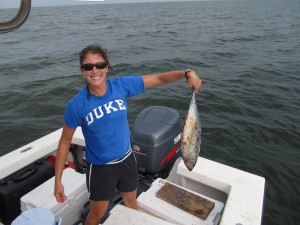
Catching a bull shark in the Neuse River is fun, but it’s not easy work. Prepping for the fieldwork starts days before and includes thawing out the massive false albacore and barracuda that we use for bait. Conveniently, my office is located in a separate building, so I am immune to the smell of thawing bait as the day heats up (we’ve been having temperatures above 100° here – stinky!). On the day of a trip to the Neuse, my willing crew meets me at the lab at 6 am to load up the boat with all of our gear. The willing crew quickly realizes that I am using them for: 1) their field skills 2) their company, and, perhaps most importantly, 3) their raw strength. Don’t worry – I compensate them with snack food. We leave the dock at the marine lab and head up Adam’s Creek to the mighty Neuse River. It’s about an hour and a half boat trip to Turnagain Bay, which has been the site that we’ve been fishing at most recently.
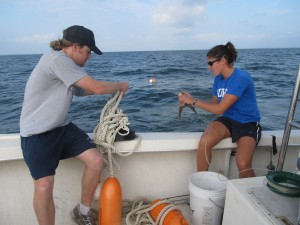
Now, you may ask why we are fishing for bull sharks up in the Neuse, a body of water with salinity around 21 ppt. Keep in mind that seawater is around 35 ppt, so the Neuse is considered brackish. However, bull sharks are super cool because they can tolerate fresh water and can travel up into brackish rivers. They may do this for many reasons, such as to exploit a food source that other sharks can’t access or to protect their pups from other shark species. Not many people around here believe that there are many (or any) bull sharks up in the Neuse, but the fishermen there occasionally have red drum snatched by something big. Lucky for me, the local fishermen have been extremely helpful (especially George Beckwith of Down East Guide Service and Tom Roller of WaterDog Guide Service).
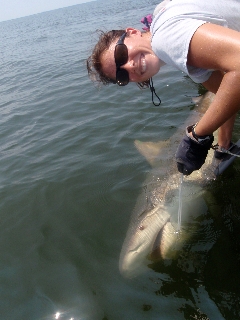
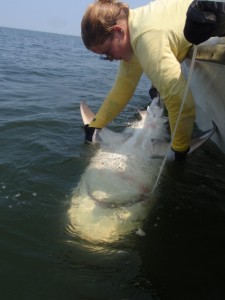
And, to prove all those non-believers wrong, we have happened to catch some bull sharks up in the Neuse – most recently, a 2.5-meter mature male. We catch the sharks using a combination of drumlines and a short longline. We use bottom-set drumlines in the Neuse, meaning that a 35-lb weight sits on the bottom of the river with a monofilament leader that has one baited hook at the end. The drumline has a float that sits on the surface, so we can see where our gear is and haul it up to check it every two hours (once again, have I mentioned that I appreciate my crew’s strength?). Drumlines are nice because a hooked fish has a lot of room to swim around the drum. The longline soaks for one hour in-between the drumline checks. If there is no shark on any of our hooks, we repeat the process of baiting, setting, and hauling the gear throughout the day. This process is punctuated by snack breaks, dreams of going for a refreshing dip in the river, and wagers on which hook will come up with a shark on it.
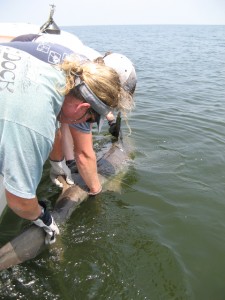
When we catch a shark, we bring it alongside the boat to process it. This, as you might guess, also requires some muscle power from the crew. One person handles the head (the “bitey bits”), one person hugs the shark around the middle, and the third is in charge of the tail. Once the shark is parallel to the boat, we measure it (quickly moving the tape measure away from the bitey bits) and give it a nice, new piece of jewelry (a roto tag) so that we can recognize it if we catch it again. Then, we roll the shark over to sex it (males have claspers), take a blood sample for stable isotope analysis, and attach a sonic tag. This tag lets us track the shark once we release it.
Once the shark is ready to be released, and our ribs are all sore from leaning over the side of the boat, my requirements from the crew switch from pure muscle to patience and delicate hearing. Every five minutes, we listen for the tag using a hydrophone. Then, we follow the tagged shark with the boat, recording our track on our GPS. We are interested in figuring out where bull sharks spend most of their time in the Neuse River to see if predation risk from bull sharks influences bottlenose dolphin habitat use. A former Ph.D. student of Dr. Read’s, Damon Gannon, studied dolphin habitat use in the Neuse River for his dissertation. Damon found that, although the prey of dolphins (mostly spot and croaker) are distributed throughout the estuary, the dolphins are only found along the edges – in waters less than 2 m deep. He hypothesized that this pattern might represent predator avoidance in the turbid and tannic waters of the Neuse – IF the predators (aka bull sharks) are found mostly in deeper waters. Our hope is to explain some of the habitat use patterns of the dolphins using our tracking data from the bull sharks. We have four more tags to get out this summer, and hopefully the track data from these tags will paint a nice picture of what bull sharks in the Neuse are up to.
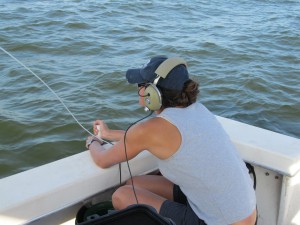
So, why should anyone (besides red drum fishermen) care about bull sharks in the Neuse? This research project interests me because it may turn out to be another example of how important predators are in structuring aquatic communities. My previous research focused on how predators influence the behavior of their prey (e.g., tiger sharks influence cormorant diving behavior), and since coming to Duke University I have focused on whether our current methods of protecting apex predators are effective. As we continue to remove apex predators from our oceans, it is important to understand the consequences of our actions. In theory, removing bull sharks from coastal areas in North Carolina could impact local bottlenose dolphin populations and, consequently, the fish that those dolphins eat. Often, the removal of these apex predators causes a cascade effect – picture a train of dominoes falling over one by one. As the hand that starts the train of dominoes, it is in our best interest to understand just where those dominoes will fall.
Holy crap that is awesome. I’ve been wondering how long it would take someone in NC to finally do something like this.
That’s so cool! Post more pictures!
Great blog post! I love the pics! 77 pictures was not enough. Make Danielle take more next time.
You legend;)!!!!
Great explanation of what you’re doing and terrific photos! Go visit an island somewhere, accessible by ferry or bridge, of course, and come be a guest blogger on my website, please!
Awesome research! As a recent marine bio grad, I just got a job as a marine fisheries observer (very excited to be getting some marine bio field experience). I will be going out with Neuse River fishermen, out of New Bern. If you ever want/need any additional crew members…I’d love to come out and help!
Way cool. I’m so glad that you’re doing such important work out there as I sit in my office contemplating where to go to lunch. Keep up the great work.
great to see that there are also people doing research on these animals instead of just hunting them. 🙂
great stuff! I participated on my first tag/capture last thursday for Eastern Pacific Green Turtles in San Diego Bay. Although it took around 6 individuals to carry a 150 kilo turtle, I can’t imagine tagging a shark at the size. Being in the field is definitely where it’s at. Thanks for the pictures! NOAA won’t let us take pictures of our turtles 🙁
This is terrific information. glad to see another Dukie trying to protect sharks, even the scary ones like tigers and bullsharks. they are so cool, and so important to the ecosytem! Keep it going!
Meagan, I have lived here the majority of my life. I never dreamed of bull sharks thriving in the Neuse River before. Great article!
that’s just frickin’ awesome!
how quickly did the bull go into tonic immobility after you flipped them?
also, when did you attach the laser beams to their heads?
We are fairly new residents to this area, and although we were surprised to see dolphin in the White Oak River, we never realized there were sharks going up the Neuse! Incredible!
that is really cool,some great pictures.i would love to fish for them and have others tag them.did you see we had a bull shark in the hudson river way up near the bridge??.talk to you later.
Wow that’s no small shark. Where is that great map you made?!?
Great to see the project continues! Keep up the great research!